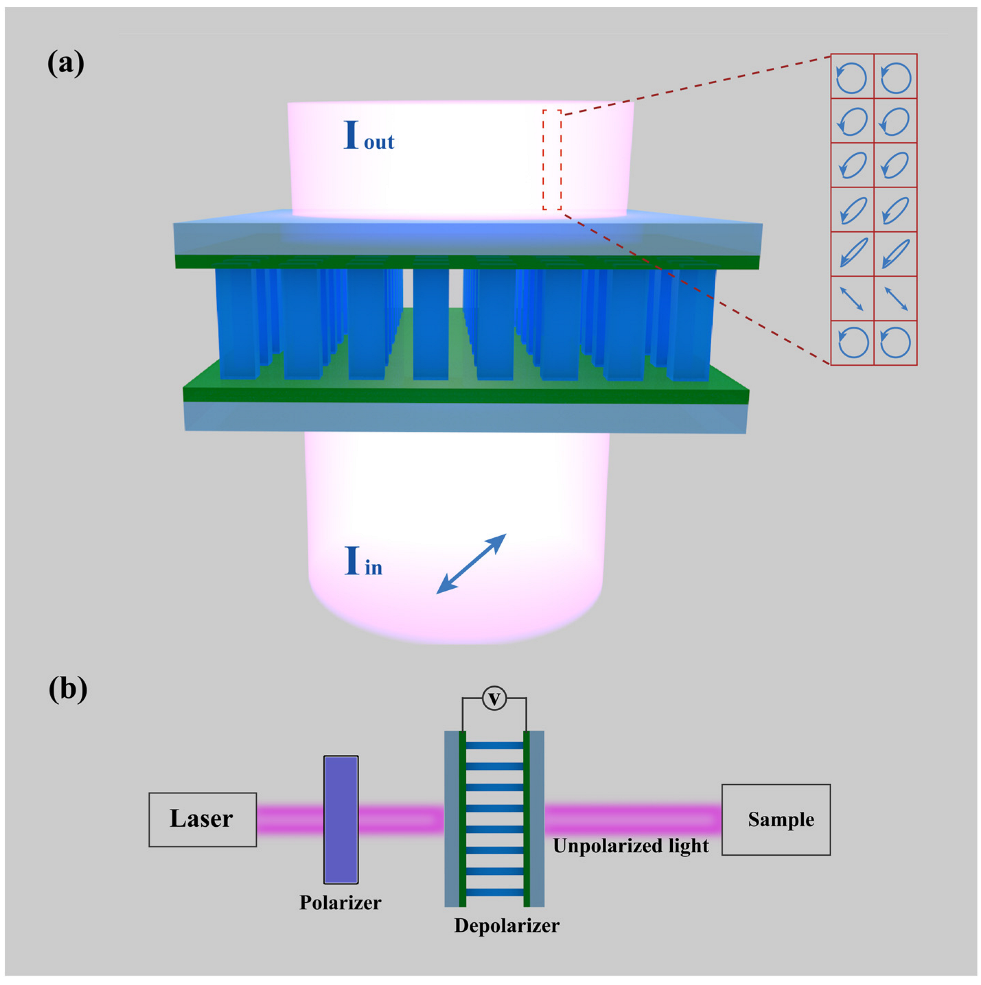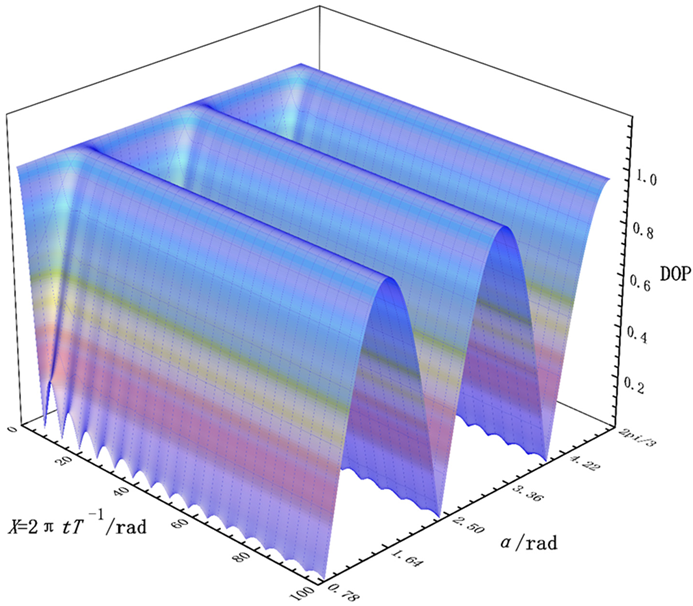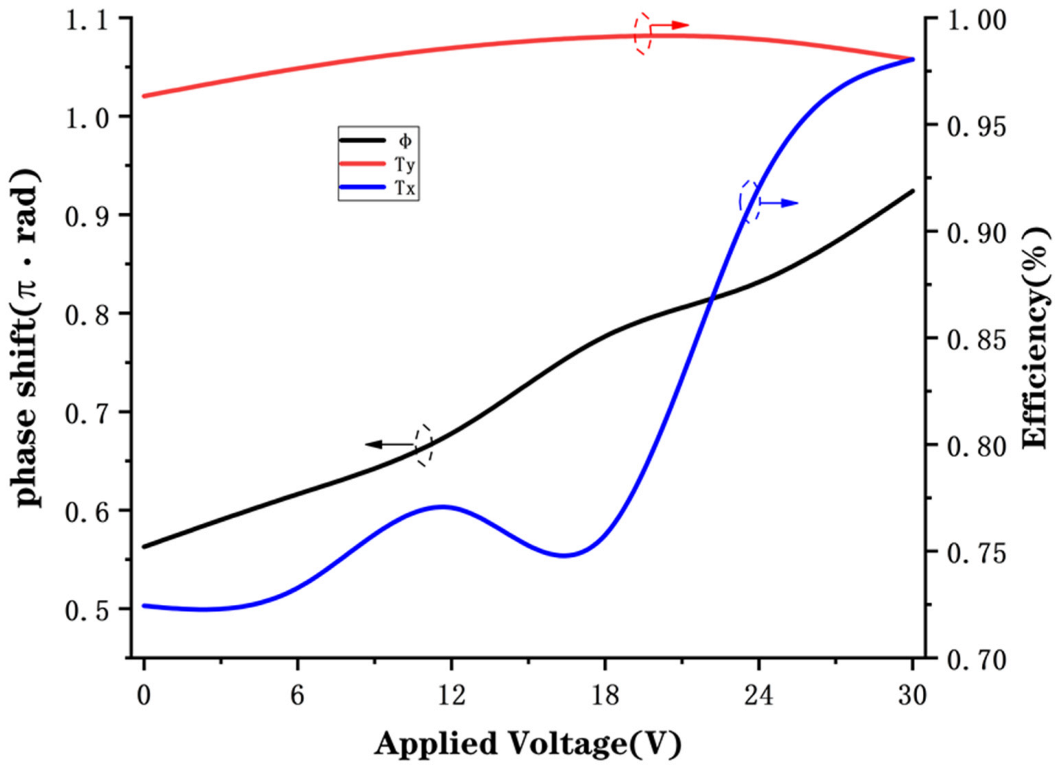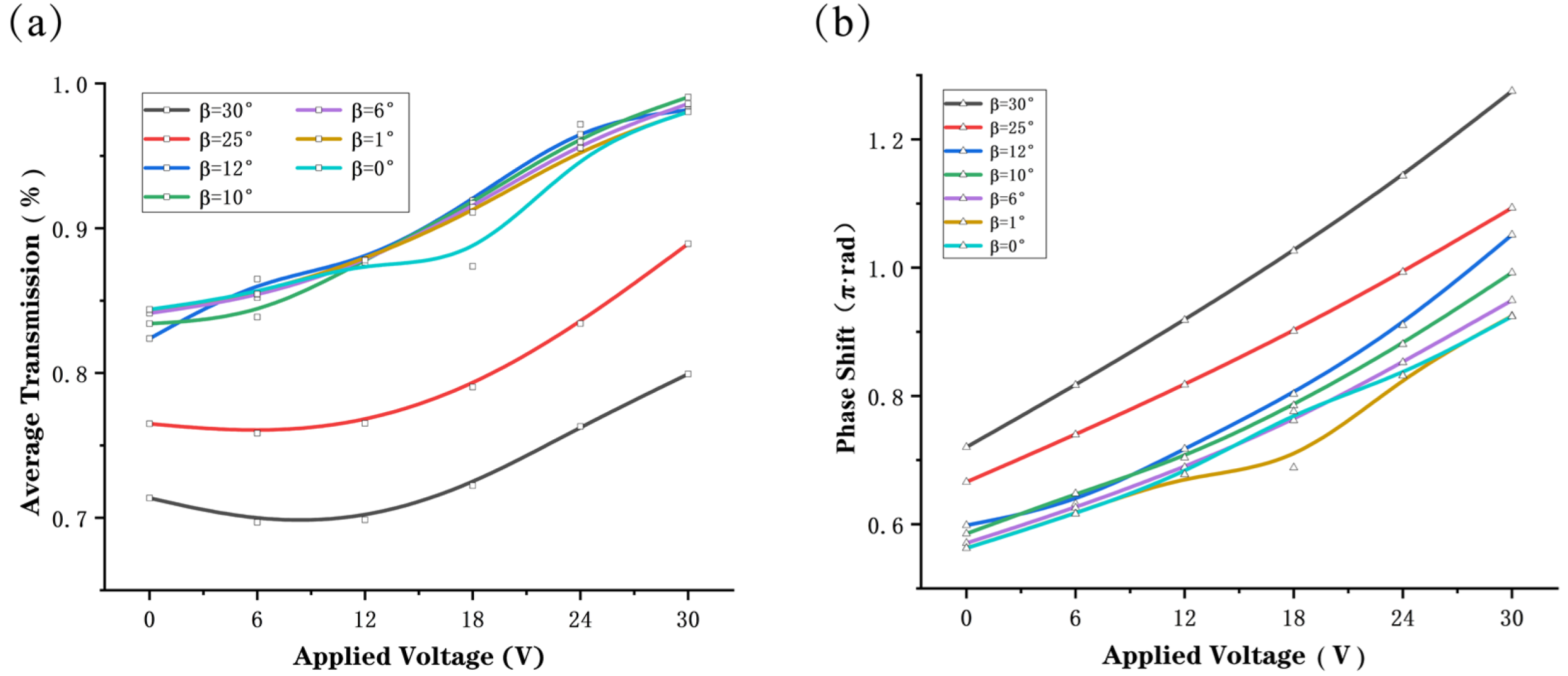Electronically Controlled Time-Domain Integral Average Depolarizer Based on a Barium Titanate (BTO) Metasurface
Abstract
:1. Introduction
2. Materials and Methods
2.1. The Electronically Adjustable Waveplates
2.2. Implementation of Depolarizers
3. Results and Discussion
4. Conclusions
Author Contributions
Funding
Institutional Review Board Statement
Informed Consent Statement
Data Availability Statement
Conflicts of Interest
References
- Goldstein, D. Polarized Light, 2nd ed.; Marcel Dekker: New York, NY, USA, 2003; p. 53. [Google Scholar]
- Poole, C.D.; Wagner, R.E. Phenomenological approach to polarisation dispersion in long single-mode fibres. Electron. Lett. 1986, 22, 1029–1030. [Google Scholar] [CrossRef]
- Shen, P.; Palais, J.C.; Lin, C. Tunable singlemode fibre depolariser. Electron. Lett. 2002, 33, 1077–1078. [Google Scholar] [CrossRef]
- Mcclain, S.C.; Chipman, R.A.; Hillman, L.W. Aberrations of a horizontal-vertical depolarizer. Appl. Opt. 1992, 31, 2326–2331. [Google Scholar] [CrossRef]
- Shen, P.; Palais, J.C. Passive single-mode fiber depolarizer. Appl. Opt. 1999, 38, 1686–1691. [Google Scholar] [CrossRef]
- Loeber, A.P. Depolarization of white light by a birefringent crystal. II. The Lyot depolarizer. J. Opt. Soc. Am. 1982, 72, 650–656. [Google Scholar] [CrossRef]
- Makowski, P.L.; Szymanski, M.Z.; Domanski, A.W. Lyot depolarizer in terms of the theory of coherence-description for light of any spectrum. Appl. Opt. 2012, 51, 626–634. [Google Scholar] [CrossRef]
- Cooper, P.R. All-fibre Lyot depolarizer. Opt. Laser Technol. 1986, 18, 99–100. [Google Scholar] [CrossRef]
- Yang, Z.; She, X.; Wang, C.G.; Chen, K.; Chen, X.F.; Shu, X.W. A Type of Lyot Fiber Depolarizer Based on Photonic Crystal Fiber. IEEE Photonics Technol. Lett. 2018, 30, 642–645. [Google Scholar] [CrossRef]
- Kong, Y.; Du, T.Y.; Wang, Y.Q.; Ansari, F. Analysis the temperature effect on the output polarization degree of the fiber Lyot depolarizer. Optik 2019, 179, 617–623. [Google Scholar] [CrossRef]
- Biener, G.; Niv, A.; Kleiner, V.; Hasman, E. Computer-generated infrared depolarizer using space-variant subwavelength dielectric gratings. Opt. Lett. 2003, 28, 1400–1402. [Google Scholar] [CrossRef]
- Billings, B.H. A Monochromatic Depolarizer. J. Opt. Soc. Am. 1951, 41, 966–975. [Google Scholar] [CrossRef]
- Wei, B.-Y.; Chen, P.; Ge, S.-J.; Zhang, L.-C.; Hu, W.; Lu, Y.-Q. Liquid crystal depolarizer based on photoalignment technology. Photon. Res. 2016, 4, 70–73. [Google Scholar] [CrossRef]
- Diorio, N.J., Jr.; Fisch, M.R.; West, J.L. Filled liquid crystal depolarizers. J. Appl. Phys. 2001, 90, 3675–3678. [Google Scholar] [CrossRef]
- Bagan, V.A.; Davydov, B.L.; Samartsev, I.E. Characteristics of Cornu depolarisers made from quartz and paratellurite optically active crystals. Quantum Electron. 2009, 39, 73–78. [Google Scholar] [CrossRef]
- Zhang, D.; Fei, L.; Luo, Y.; Li, J.; Wang, W. Cholesteric liquid crystal depolarizer. Opt. Eng. 2007, 46, 070504. [Google Scholar] [CrossRef] [Green Version]
- Hu, Y.; Ou, X.; Zeng, T.; Lai, J.; Zhang, J.; Li, X.; Luo, X.; Li, L.; Fan, F.; Duan, H. Electrically Tunable Multifunctional Polarization-Dependent Metasurfaces Integrated with Liquid Crystals in the Visible Region. Nano Lett. 2021, 21, 4554–4562. [Google Scholar] [CrossRef] [PubMed]
- Dolan, J.A.; Cai, H.; Delalande, L.; Li, X.; Martinson, A.B.F.; de Pablo, J.J.; López, D.; Nealey, P.F. Broadband Liquid Crystal Tunable Metasurfaces in the Visible: Liquid Crystal Inhomogeneities Across the Metasurface Parameter Space. ACS Photonics 2021, 8, 567–575. [Google Scholar] [CrossRef]
- Kowerdziej, R.; Wróbel, J.; Kula, P. Ultrafast electrical switching of nanostructured metadevice with dual-frequency liquid crystal. Sci. Rep. 2019, 9, 20367. [Google Scholar] [CrossRef] [PubMed] [Green Version]
- Ma, Z.; Meng, X.; Liu, X.; Si, G.; Liu, Y.J. Liquid Crystal Enabled Dynamic Nanodevices. Nanomaterials 2018, 8, 871. [Google Scholar] [CrossRef] [Green Version]
- Schau, P.; Fu, L.; Frenner, K.; Schäferling, M.; Schweizer, H.; Giessen, H.; Venancio, L.M.G.; Osten, W. Polarization scramblers with plasmonic meander-type metamaterials. Opt. Express 2012, 20, 22700–22711. [Google Scholar] [CrossRef] [Green Version]
- Fu, L.; Berrier, A.; Li, H.; Schau, P.; Frenner, K.; Dressel, M.; Osten, W. Depolarization of a randomly distributed plasmonic meander metasurface characterized by Mueller matrix spectroscopic ellipsometry. Opt. Express 2016, 24, 28056–28064. [Google Scholar] [CrossRef]
- Yuanmu, Y.; Wenyi, W.; Parikshit, M.; Ivan, I.K.; Dayrl, P.B.; Jason, V. Dielectric Meta-Reflectarray for Broadband Linear Polarization Conversion and Optical Vortex Generation. Nano Lett. 2014, 14, 1394–1399. [Google Scholar] [CrossRef]
- Arbabi, E.; Kamali, S.M.; Arbabi, A.; Faraon, A. Full-Stokes Imaging Polarimetry Using Dielectric Metasurfaces. ACS Photonics 2018, 5, 3132–3140. [Google Scholar] [CrossRef] [Green Version]
- Huo, P.; Zhang, C.; Zhu, W.; Liu, M.; Zhang, S.; Zhang, S.; Chen, L.; Lezec, H.J.; Agrawal, A.; Lu, Y.; et al. Photonic Spin-Multiplexing Metasurface for Switchable Spiral Phase Contrast Imaging. Nano Lett. 2020, 20, 2791–2798. [Google Scholar] [CrossRef] [PubMed]
- Rubin, N.A.; D’Aversa, G.; Chevalier, P.; Shi, Z.; Chen, W.T.; Capasso, F. Matrix Fourier optics enables a compact full-Stokes polarization camera. Science 2019, 365, eaax1839. [Google Scholar] [CrossRef]
- Ni, X.; Kildishev, A.V.; Shalaev, V.M. Metasurface holograms for visible light. Nat. Commun. 2013, 4, 2807. [Google Scholar] [CrossRef]
- Chen, W.T.; Yang, K.-Y.; Wang, C.-M.; Huang, Y.-W.; Sun, G.; Chiang, I.D.; Liao, C.Y.; Hsu, W.-L.; Lin, H.T.; Sun, S.; et al. High-efficiency broadband meta-hologram with polarization-controlled dual images. Nano Lett. 2014, 14, 225–230. [Google Scholar] [CrossRef]
- Huang, L.; Chen, X.; Muehlenbernd, H.; Zhang, H.; Chen, S.; Bai, B.; Tan, Q.; Jin, G.; Cheah, K.-W.; Qiu, C.-W. Three-dimensional optical holography using a plasmonic metasurface. Nat. Commun. 2013, 4, 2808/2801–2808/2809. [Google Scholar] [CrossRef] [Green Version]
- Khorasaninejad, M.; Ambrosio, A.; Kanhaiya, P.; Capasso, F. Broadband and chiral binary dielectric meta-holograms. Sci. Adv. 2016, 2, e1501258. [Google Scholar] [CrossRef] [Green Version]
- Li, X.; Chen, L.; Li, Y.; Zhang, X.; Pu, M.; Zhao, Z.; Ma, X.; Wang, Y.; Hong, M.; Luo, X. Multicolor 3D meta-holography by broadband plasmonic modulation. Sci. Adv. 2016, 2, e1601102. [Google Scholar] [CrossRef] [Green Version]
- Wen, D.; Yue, F.; Li, G.; Zheng, G.; Chan, K.; Chen, S.; Chen, M.; Li, K.F.; Wong, P.W.H.; Cheah, K.W.; et al. Helicity multiplexed broadband metasurface holograms. Nat. Commun. 2015, 6, 8241. [Google Scholar] [CrossRef] [PubMed]
- Wang, Y.; Zhu, W.; Zhang, C.; Fan, Q.; Chen, L.; Lezec, H.; Agrawal, A.; Xu, T. Ultra-compact visible light depolarizer based on dielectric metasurface. Appl. Phys. Lett. 2020, 116, 0511031–0511035. [Google Scholar] [CrossRef] [PubMed]
- Abel, S.; Eltes, F.; Ortmann, J.E.; Messner, A.; Castera, P.; Wagner, T.; Urbonas, D.; Rosa, A.; Gutierrez, A.M.; Tulli, D.; et al. Large Pockels effect in micro- and nanostructured barium titanate integrated on silicon. Nat. Mater. 2019, 18, 42–47. [Google Scholar] [CrossRef] [PubMed]
- Bibbò, L.; Liu, Q.; Khan, K.; Yadav, A.; Elshahat, S.; Deng, Z.-L.; Ouyang, Z. High-speed amplitude modulator with a high modulation index based on a plasmonic resonant tunable metasurface. Appl. Opt. 2019, 58, 2687–2694. [Google Scholar] [CrossRef]
- Kruk, S.; Hopkins, B.; Kravchenko, I.I.; Miroshnichenko, A.; Neshev, D.N.; Kivshar, Y.S. Invited Article: Broadband highly efficient dielectric metadevices for polarization control. APL Photonics 2016, 1, 030801. [Google Scholar] [CrossRef] [Green Version]






Publisher’s Note: MDPI stays neutral with regard to jurisdictional claims in published maps and institutional affiliations. |
© 2022 by the authors. Licensee MDPI, Basel, Switzerland. This article is an open access article distributed under the terms and conditions of the Creative Commons Attribution (CC BY) license (https://creativecommons.org/licenses/by/4.0/).
Share and Cite
Jie, K.; Huang, H.; Qin, S.; Guo, J.; Liu, H.; Meng, H.; Wang, F.; Yang, X.; Wei, Z. Electronically Controlled Time-Domain Integral Average Depolarizer Based on a Barium Titanate (BTO) Metasurface. Nanomaterials 2022, 12, 1228. https://doi.org/10.3390/nano12071228
Jie K, Huang H, Qin S, Guo J, Liu H, Meng H, Wang F, Yang X, Wei Z. Electronically Controlled Time-Domain Integral Average Depolarizer Based on a Barium Titanate (BTO) Metasurface. Nanomaterials. 2022; 12(7):1228. https://doi.org/10.3390/nano12071228
Chicago/Turabian StyleJie, Kaiqian, Hui Huang, Shuai Qin, Jianping Guo, Hongzhan Liu, Hongyun Meng, Faqiang Wang, Xiangbo Yang, and Zhongchao Wei. 2022. "Electronically Controlled Time-Domain Integral Average Depolarizer Based on a Barium Titanate (BTO) Metasurface" Nanomaterials 12, no. 7: 1228. https://doi.org/10.3390/nano12071228
APA StyleJie, K., Huang, H., Qin, S., Guo, J., Liu, H., Meng, H., Wang, F., Yang, X., & Wei, Z. (2022). Electronically Controlled Time-Domain Integral Average Depolarizer Based on a Barium Titanate (BTO) Metasurface. Nanomaterials, 12(7), 1228. https://doi.org/10.3390/nano12071228











